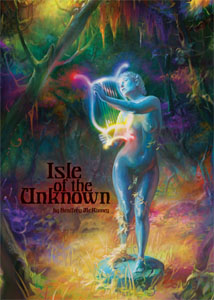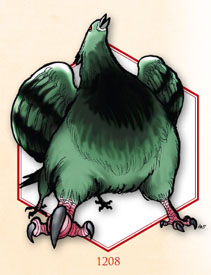 Take a moment to consider this:
Take a moment to consider this:
A four-legged pigeon is the size of an apatosaurus, and in combat a display of feathers rises behind the creature’s head. (…) At will, the giant pigeon can shape-shift into a giant yellow spider.
If that sort of thing — along with 7′ tall parrots who are always on fire and 12′ long blue jays without legs — sounds interesting and useful to you, then you’re going to love Isle of the Unknown. If it doesn’t, however, then you’re probably going to be struggling to find much utility between its covers.
Isle of the Unknown presents an interesting contrast to Carcosa (Geoffrey McKinney’s other deluxe hexcrawl product from Lamentations of the Flame Princess). Unlike the bland and boring key entries for Carcosa, Isle of the Unknown — which describes an island roughly 150 miles wide — is generally specific, clever, and creative. Unfortunately, it presents a very different set of problems which, nevertheless, cripple the product for me.
First, there are the monsters. Although occasionally spiced with some interesting abilities, they really are giant pigeons all the way down: Pick a random animal. Make it bigger than normal. Randomly determine the number of limbs it possesses. Now, randomly combine it with another animal; light it on fire; have it ooze pus; or give it a random spell-like ability. Ta-Da! You’ve re-created the vast majority of the monsters in this book.
 Second, although in a hex-to-hex comparison Isle of the Unknown is much improved compared to Carcosa, in totality it ends up being just as bland by over-saturating its themes.
Second, although in a hex-to-hex comparison Isle of the Unknown is much improved compared to Carcosa, in totality it ends up being just as bland by over-saturating its themes.
Let me explain: I think themes are very important in creating interesting hexcrawl or dungeoncrawl keys. Themes give a location its identity and make it memorable. Without a proper theme, a ‘crawl turns into a random funhouse. But if a theme is too narrow and relied on too heavily, then it becomes repetitive. (For example, enchanted vales which remain perpetually in springtime regardless of the weather outside simply stop being magical when there are something like a dozen of them scattered around the island.)
In the case of Isle of the Unknown, McKinney describes the scope of his key like this:
To aid the Referee, only the weird, fantastical, and magical is described herein. The mundane is left to the discretion of the campaign Referee, to be supplied according to the characteristics of his own conceptions or campaign world. Detailed encounter tables (for example) of French knights, monks, pilgrims, etc. would be of scant use to a Referee whose campaign world is a fantasy version of pre-Colombian America. Similar considerations led to the exclusion of most proper names.
Couple important things to understand about this: First, it’s untrue. The key includes a lot of “mundane” detail (most notably all the major communities on the island). Second, it’s nonsense. You can’t say “if I don’t give this guy a proper name, then it’ll be easy to slot him in as a pre-Colombian American” and then describe him as “a robust and jovial man of middle years with blue eyes and curling reddish hair and beard (…) he loves nothing so much as the hunt, save perhaps his dozen Scottish Deerhounds”.
What McKinney really means is that 95% of his hex key is going to be broken down into three categories: Monsters, Magical Statues, and high-level Magic-Users/Clerics who all live by themselves as bucolic hermits.
And on an individual level, most of this content is at least interesting. But if you attempted to actually run a hexcrawl using this hex key, the result would be incredibly boring due to its repetition: “Magic statue, bucolic hermit, bucolic hermit, giant parrot, magic statue, humanoid bluejay, magic statue, magic statue…”
So, ultimately, I’m forced to conclude that the book is not very useful in its intended function as a hexcrawl. However, it may have some value as an inefficiently organized bestiary and the like… but only if you like giant, flaming parrots.
In closing, it must be noted that, once again, Lamentations of the Flame Princess have created a book which is both beautiful and useful. Although completely different in its aesthetic from Carcosa, Isle of the Unknown is nevertheless gorgeous: Excellent illustrations, rich lay-out, high-quality paper, durable binding. (My only caveat would be that the map of the island, while very pretty, does not clearly identify the terrain type in each hex. From a utility standpoint, that’s a fatal flaw in a hexcrawl product.)
Style: 5
Substance: 3












I found the same thing. The monsters just came across as stupid, something a child would think up.
I also would have been more interested in the interactions between the people, high level Magic Users and Clerics, and the statues. If there is a statue that lets you talk to animals do people travel to it regularly? Has someone tried to claim it?
I haven’t read through most of the hexes because it just didn’t like it that much but it didn’t look like they interact at all with each other or the population of the island.
John.
This review captures both my interest in, and frustration with the product. The basic concept is very intriguing, and there are details which work very well – all of the magicians, for example, are interesting. The book is visually pleasing, well presented and physically solid. I could envision a low level, maybe E6 or even E3 game working well in the basic setting.
But as you write, Isle of the Unknown is oversaturated. And not just that; there is a level of strangeness in monsters where it turns from weird to just jarring, predictable and silly. If we look at the Clark Ashton Smith stories that inspired Isle of the Unknown, or C. L. Moore’s Jirel stories, which take place in a slightly similar (although darker and more sensuous) setting, there is a good balance: a method to the madness and a madness to the method. There is no method to these monsters, and like John remarks, no connections to each other or their surroundings. I would simply remove all of them from the book and do something with the rest. Still a lot of work, but at least a good start.
Hey Justin,
These are fun commentaries to read, mostly so I don’t make the same mistakes when I design personal D&D components.
I don’t know what your ranking system includes though.
Style 5, Substance 3? Based on your critique, I think they’re out of 10.
Thanks,
To ‘Melan’ – good post dude/dudette! I like the idea of a ‘darker and sensuous setting’. That’s something I try to create but I can’t quite catch the flavor. I’ll be sure to check that out.
Also, you’re using way too many commas. Most of the time, your second clause can be placed first and you can withdraw at least one comma.
Conversely, your second clause, most of the time, can be placed first so that you can withdraw a comma. 😀
Yeah, I had very high hopes for this one and decided to buy it instead of Carcosa. A real let-down, for the most part. I agree the monsters are mostly silly. I like having a collection of offbeat statues and wizards, but if were to try to run this as an island, I’d have to restock an awful lot of hexes.
It is a pretty an well-made book though.
Dear Aris,
my use of commas and clauses is, I can assure you, intentional. I am, also, definitely a dude.
@Aris: 1-5 scale. I’m falling back on the habit of using RPGNet’s rating scheme.
The wizards/clerics are definitely the highlight here. The statues aren’t bad (but a little repetitive). The island as a whole might be salvageable if you could come up with some sort of over-arching scheme that would explain why the island is a refuge for a bunch of powerful, solo casters living off nature’s bounty.
My other thought was that you could grab most of these casters, strew ’em around an archipelago, and have a pretty good seed for an Odyssey-style wavecrawl.
I think the thing is that actual creatures from Clark Ashton Smith are creepy, horrific, and distinctly filled with a supernatural otherness. Giant, four-legged pigeons that can turn into yellow spiders don’t have the same kick for me. And none of the statues have the enigmatical allure of Moore’s “Black God’s Kiss” for me.
Definitely some usable stuff here (that’s why it got a 3 for Substance), but the totality is lacking.
@ Melan: nice dude!